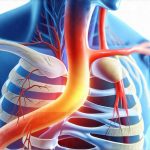The sensation of digestive discomfort after meals is remarkably common, ranging from mild bloating and gas to more pronounced cramping and nausea. Often overlooked in discussions about gut health are the subtle yet significant connections between our abdominal muscles and the efficiency of digestion. While we typically associate muscle tension with physical exertion or stress, chronic low-grade tension in the abdominal region – often a result of posture, breathing patterns, or even habitual bracing – can inadvertently impede optimal digestive function. This isn’t to suggest that strong abs are inherently detrimental; rather, it highlights the importance of balanced muscle tone and the potential for restrictions to disrupt the natural processes of peristalsis (the wave-like contractions that move food through the digestive tract) and nutrient absorption. Understanding digestive bacteria is also important for overall gut health.
The interplay between abdominal muscles and digestion is a complex one, often involving subconscious patterns developed over time. Many individuals unknowingly engage their abdominal muscles as a protective mechanism – perhaps in response to past discomfort or as a learned habit stemming from anxiety – effectively creating an internal bracing that limits the natural expansion and contraction needed for healthy digestion. This can manifest as a feeling of tightness, even when not consciously flexing, and contribute to symptoms like bloating, constipation, or difficulty processing certain foods. Understanding this connection is crucial for developing strategies to promote digestive ease and overall wellbeing, focusing on mindful movement, relaxation techniques, and addressing any underlying postural imbalances that might be contributing to chronic tension. Improving posture can significantly reduce digestive discomfort as well.
The Role of Abdominal Muscle Tension in Digestive Processes
Abdominal muscle tension doesn’t exist in isolation; it’s intricately linked to the entire digestive system. When muscles are overly tense or constricted, they can directly impact the motility of the gut – meaning how efficiently food moves along the digestive tract. Consider the diaphragm, a primary breathing muscle that also plays a vital role in creating abdominal pressure to aid digestion. Shallow, chest-focused breathing often leads to reduced diaphragmatic movement and increased tension in the abdominal muscles. This restricts space for the organs, potentially hindering peristalsis and leading to stagnation of food within the digestive system. Conversely, deep, diaphragmatic breathing promotes relaxation and allows for greater flexibility in the abdomen, facilitating smoother digestion.
The relationship extends beyond motility. The abdominal muscles also provide support for the internal organs, but excessive tension can actually compress these organs, impeding their function. For example, chronic contraction of the transverse abdominis (the deepest abdominal muscle) can put pressure on the stomach and intestines, potentially exacerbating symptoms like bloating or acid reflux. Furthermore, tension in the abdominal muscles can influence blood flow to the digestive system, reducing oxygen delivery and impairing nutrient absorption. This can contribute to feelings of fatigue and overall compromised health. It’s important to remember that a healthy digestive system relies on both efficient movement and adequate circulation, both of which can be negatively affected by sustained muscle tension. The relationship between cold symptoms and digestive issues is also worth exploring.
Finally, the vagus nerve – often referred to as the “wandering nerve” – plays a critical role in regulating digestion and is significantly impacted by abdominal muscle tension. The vagus nerve connects the brain to many major organs, including the gut, and influences processes like stomach acid production, enzyme secretion, and intestinal motility. Chronic stress and tension can suppress vagal tone (the activity of the vagus nerve), leading to impaired digestive function. Relaxing the abdominal muscles and practicing techniques that stimulate the vagus nerve – such as deep breathing exercises – can help restore balance and improve gut health. Migraines are often linked to digestive upset, so this connection is important to understand.
Strategies for Releasing Abdominal Tension and Improving Digestion
Addressing abdominal muscle tension requires a multi-faceted approach, focusing on both physical release and mindful awareness. Gentle movement practices like yoga or Pilates can be incredibly beneficial, emphasizing lengthening and releasing the abdominal muscles rather than forceful contractions. Specific poses that encourage diaphragmatic breathing and spinal flexibility – such as cat-cow pose, child’s pose, and gentle twists – can help alleviate tension and promote digestive flow. However, it’s crucial to avoid exercises that excessively engage or tighten the abdominal muscles, especially during periods of acute discomfort.
Beyond movement, relaxation techniques like progressive muscle relaxation and mindfulness meditation can also play a significant role in reducing overall stress levels and releasing chronic tension. Focusing on your breath and consciously softening the abdomen can help interrupt habitual bracing patterns. Additionally, paying attention to posture – both while sitting and standing – is essential. Slouching or prolonged sitting can contribute to abdominal compression and restricted breathing. Incorporating regular breaks to stretch and move throughout the day can prevent stagnation and promote healthy muscle tone. It’s also worth considering whether any emotional factors might be contributing to chronic tension, as unresolved stress or anxiety often manifests physically in the abdomen. Understanding leaky gut and digestive gas can help address related issues.
Identifying and Addressing Postural Imbalances
Postural imbalances frequently contribute to abdominal muscle tension and subsequent digestive discomfort. A forward head posture, for instance, can lead to a rounded upper back and tightened abdominal muscles as the body attempts to compensate for the misalignment. Similarly, prolonged sitting with poor lumbar support can cause the pelvic floor muscles to become tight, impacting the diaphragm’s movement and restricting abdominal space. Identifying these imbalances is the first step towards correction. A physical therapist or qualified healthcare professional can assess your posture and recommend specific exercises or stretches to address any areas of weakness or tightness.
- Regular self-assessment: Periodically check your posture in a mirror, paying attention to the alignment of your head, shoulders, spine, and pelvis.
- Ergonomic adjustments: Ensure that your workstation is set up ergonomically, with proper chair support and monitor height.
- Strengthening exercises: Focus on strengthening muscles that counteract postural imbalances, such as the back muscles and glutes.
The Importance of Diaphragmatic Breathing
Diaphragmatic breathing, also known as belly breathing, is a powerful technique for reducing abdominal tension and promoting digestive health. Most people habitually breathe shallowly from their chest, which engages the accessory muscles of respiration and contributes to increased muscle tension in the abdomen and shoulders. Diaphragmatic breathing, on the other hand, utilizes the diaphragm – a large dome-shaped muscle at the base of the lungs – to draw air deep into the lungs, expanding the abdomen and promoting relaxation.
To practice diaphragmatic breathing:
1. Lie on your back with knees bent and feet flat on the floor.
2. Place one hand on your chest and the other on your abdomen.
3. Slowly inhale through your nose, allowing your abdomen to rise while keeping your chest relatively still.
4. Exhale slowly through your mouth, gently contracting your abdominal muscles.
5. Repeat for several minutes, focusing on the sensation of your diaphragm moving up and down with each breath.
Mindful Eating and Digestion
Mindful eating is about paying attention to the experience of eating – savoring the flavors, textures, and aromas of food without distraction. It involves slowing down, chewing thoroughly, and being present in the moment. When we eat mindfully, we’re less likely to overeat or rush through meals, which can disrupt digestive processes. Moreover, mindful eating encourages us to tune into our body’s signals of hunger and fullness, preventing discomfort and promoting a healthier relationship with food. Picky eating can also contribute to digestive discomfort.
- Eliminate distractions: Turn off the TV, put away your phone, and focus solely on your meal.
- Chew thoroughly: Break down food properly before swallowing to aid digestion.
- Eat slowly: Savor each bite and allow yourself time to enjoy the experience.
- Pay attention to fullness cues: Stop eating when you feel satisfied, not overly full.
By incorporating these strategies – addressing postural imbalances, practicing diaphragmatic breathing, and embracing mindful eating – we can significantly reduce abdominal muscle tension and promote a healthier, more comfortable digestive system. It’s about fostering a harmonious relationship between our bodies and our minds, recognizing that optimal wellbeing requires both physical and emotional balance.


















